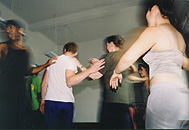|
Stay tuned... We'll keep you posted on new projects, tools, discussions, and interesting perspectives. Sign-Up! |
Tools in Action‹‹ Back to Toolbox | Tools-in-actionCaring Too Much?Communication and Structure in Facilitation
In order to teach, I have to care. Each time I step before a group of people, I need to confirm for myself that I have their best interests at heart in whatever experience we are about to embark upon. Sometimes this is all about the people in the group and their next steps. Sometimes it is about my own learning (in which case I try to let the group in on that fact). But how and how much I convey about that caring presents a dilemma. A caring teacher can be inspiring to the students. But when caring itself becomes the dominant mode of communication, it can become stultifying and may actually hinder the teacher’s best intentions. This phenomenon often shows up in community-based work, probably because nurturing people are drawn to the field. My own experience has led me to see that the best antidotes to too much caring are rigor, and tone of voice. This problem often gets played out in Blind Lead. Leaders might express their intense caring and tenderness by talking in hushed tones as they describe how to gently touch and guide a partner. This approach seems particularly common among women. I think it comes about partly as a result of the therapeutic world we now live in. The important awareness of past abuse and trauma has led to a whole generation of leadership which places the issues of recovery at the forefront of learning. In some groups it may well be useful to at least acknowledge the situation. But I have discovered other ways to handle this. Among the tremendous benefits of dancing are the multiple ways a person can discover and communicate the motivation and the meaning behind the movement. To an audience watching, or for me as a performer, I might be successful if I am feeling a lot of meaning in the dancing. Or I might be successful if I am just counting the beats. This is a fantastic thing. Therefore, I try to get my students to see both options, as well as the many in between. This means that within Blind Lead, for instance, some will want to hear and talk about trust, while others will be more interested in the pure physical problem at hand, to name just two of the many possibilities. So here are a few rules I follow when I lead Blind Lead. First, I use a matter-of-fact tone of voice. The caring is completely present inside the movement structure itself. Let the movement do the work. Secondly I talk and demonstrate at the same time the usefulness and beauty of varying the ways we touch and guide the person we are leading. This demonstration alone contains a tremendous amount of information. For people new to a movement exercise like this, it is powerful to understand that you can lead a person by the hands, by cupping the back of the head, or by holding the shoulders. These are baby steps and giant steps at the same time. And lastly I say “touch outside the bathing suit line.” I learned this phrase from Adrienne Clancy, who was a company member for three years. When I say this, there is always a giggle in the room and sometimes a moment of chatter, especially from the men. Occasionally someone will call out “Is it a two piece or a one piece?” Generally, I don’t respond to the comments but keep my focus on the person I am leading around. However, I will immediately demonstrate the answer to the questions by saying to the person, “I want to lead you by touching your middle, may I?” and then continue the dancing. I do not stop for a conversation about the reasons or particulars of where to touch a person. I am convinced that by continuing forward at this moment I am modeling a total acceptance of how we are going to take care of each other without overdoing it. I have set the tone for what is okay in this group. By using the phrase “touch outside the bating suit line,” delivered in a matter-of-fact way, I am also acknowledging to those in the group who have experienced trauma that I am aware of their past and their dilemma. As the leader I have set a public boundary that I expect to be met. That is why I don’t have the conversation. I do not want to entertain the slightest possibility that there is any other way to do this. And it is always successful. |










